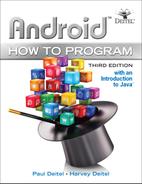Book Description
For courses in Android Programming.
Thinking like a developer — from the start.
Created by world-renowned programming instructors Paul and Harvey Deitel, Android How to Program, Third Edition introduces the dynamic world of Android smartphone and tablet app development with the Android Software Development Kit (SDK), the Java™ programming language, and the rapidly evolving Android Studio Integrated Development Environment (IDE). Updated to Android 6 and Google’s preferred Android Studio IDE, the Third Edition presents cutting-edge mobile computing technologies. The Deitels' App-driven Approach helps readers master Android app development through eight complete, working Android apps.
Each chapter features new concepts through a single app. The authors begin with an introduction to the app, followed by an app test-drive showing sample executions and a technologies overview. Next, they present detailed steps to build the app. Finally, they provide a detailed code walkthrough of the app’s source code, discussing the programming concepts and Android APIs used in the app. The book also has an extensive introduction to programming using the Java language, making it appropriate for Java courses that want to add an app-programming flavor.
